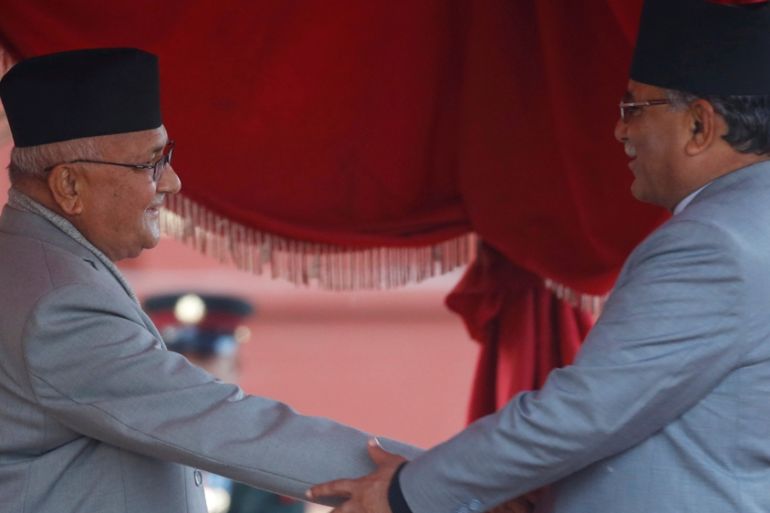Feuding in Nepal’s communist alliance threatens merger
Analysts say ruling communist party and its junior ally, the Maoists, are ‘in permanent chaos’ over governance.

Kathmandu, Nepal – On the afternoon of April 22, top members of Nepal’s two largest communist parties gathered at the dilapidated national assembly hall in Kathmandu.
The day held special significance to them because it was the 148th birthday of Vladimir Lenin, the founder of the Russian Communist Party and a figure much loved by Nepal’s former revolutionary Maoists.
The Communist Party of Nepal (Unified Marxist-Leninist), or CPN-UML, and the Communist Party of Nepal (Maoist Centre) had originally planned to merge their parties on Lenin’s birthday.
But conspicuously absent from the banner tucked on the wall at Rashtriya Sabha Griha were images of Lenin and fellow communist revolutionaries: Karl Marx and China’s Mao Zedong.
Instead the banner had portraits of three late Nepali communist pioneers and leaders.
That’s because the CPN-UML had removed the images of Lenin, Marx and Mao from its flags and other official documents more than 15 years ago.
In response, an angry group of Maoist members climbed up to the stage and removed the banner, which also bore images of other senior leaders including Khadga Prasad Sharma Oli, Nepal’s prime minister.
After days of talks between the two leaders failed, Oli and Pushpa Kamal Dahal, the Maoist chairman, had decided to use Lenin’s birthday to calm their followers about the impending merger.
Though the event resumed hours later under the two banners, the commotion highlighted the difficulties about the merger of Nepal’s communists, analysts said.
In October, the CPN-UML and Maoists announced an electoral alliance and a merger in the future.
They eventually won a landslide in the national and provincial assemblies in elections late last year under a new constitution.
As the leader of the largest party in the parliament, CPN-UML’s Oli was elected prime minister, with the Maoists serving as a junior partner in the coalition.
In the elections, the two parties struck a 60 to 40 seat-sharing deal, but the results showed that the CPN-UML won 70 percent of seats.
Party differences
The alliance had won the elections on the platform of political stability and economic prosperity.
The had promised a stable government that could complete its full five-year term, a rarity in the last two decades of parliamentary democracy.
People were also eager to reap the peace dividend after enduring a 10-year fighting, which ended in 2006. An estimated 16,000 people were killed in the fighting.
Moreover, Nepalis wanted to see their country emerge from extreme poverty and chronic under-development.
Mani Thapa, a Maoist leader, however, told Al Jazeera that the differences between the two parties could be hard to reconcile.
“The Maoists have always been rebels. They have been outside the political mainstream most of the time. They don’t have much experience running a government; they don’t adhere to diplomatic niceties,” he said.
On the other hand, the CPN-UML functions like an non-government organisation, and is adept at running a government, Thapa said.
The base of the CPN-UML is middle class and lower middle class, whereas Maoists drew their support from working-class people, though some leaders have become rich over the years, Thapa added.
While political commentator Bishnu Sapkota agreed that politics made strange bedfellows, recalling how Oli challenged the Maoists a few years ago.
“There are significant differences between the two leaders on their views on [Maoist] insurgency,” Sapkota said.
‘Mutual suspicion’
The landslide victory in the polls motivated the two to find a common ground, according to Sapkota.
“People endorsed the alliance by voting them with majority. They were thrust into a situation where they are bound to think singularly,” he said.
But he also cautioned that a majority of the two parties’ leaders were deeply suspicious of one another.
Sapkota pointed out that a few Maoist leaders such as Gopal Kirati, who left an ethnicity-based group and joined Maoists, and Bishwa Bhakta Dulal, a prominent Dalit activist, have opposed the merger.
Political observers have also noticed that Oli and Dahal are poles apart in their political dealings.
“Oli rarely listens to his advisers and is known to have a hardline attitude,” said Mani Dahal, who covers politics for Nagarik, a Nepali language newspaper in Kathmandu.
Though both leaders are willing to take political risks to further their career, Dahal, who often consults his party colleagues, is well-organised, according to sources.
Thapa, the Maoist leader, echoed his party chairman Dahal, arguing that the merger must be on the basis of equality.
Despite the hurdles, Thapa favoured continuing with talks.
“The merger may not happen soon, but we must engage in dialogues because we are working to realise our socialism-oriented goal enshrined in the constitution,” he said.